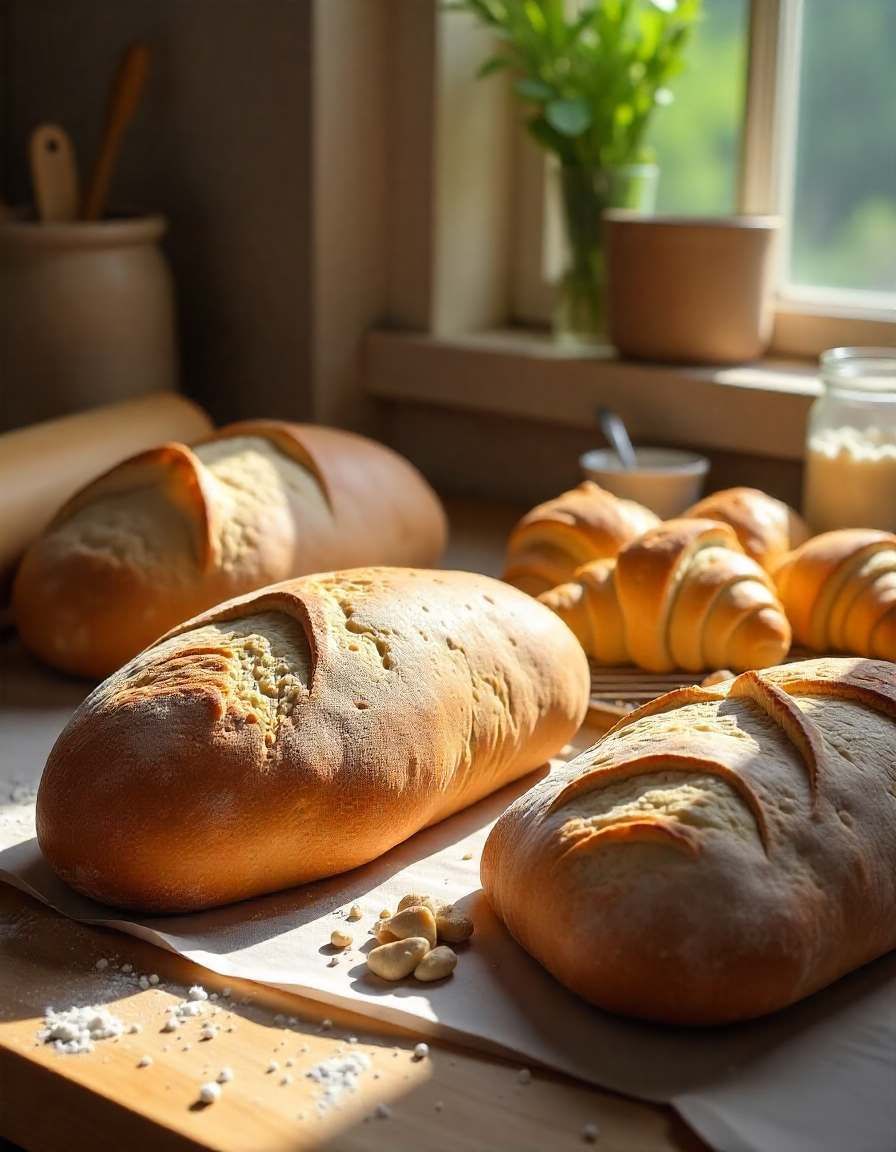Baking at home can feel like stepping into an alchemist’s workshop—transforming simple ingredients like flour, water, and yeast into golden loaves and delicate pastries that fill the house with irresistible aromas. This guide dives deep into the art and science of home baking, offering practical tips, techniques, and insights to help you craft bakery-quality goods in your own kitchen. Whether you’re a novice kneading your first dough or a seasoned baker looking to refine your craft, this guide is packed with actionable advice to elevate your skills.
Understanding the Essentials: Ingredients and Tools
Every great bake starts with quality ingredients. Flour is the backbone of most recipes, and not all flours are created equal. Bread flour, with its higher protein content (12-14%), gives structure to hearty loaves like sourdough or baguettes. All-purpose flour works well for softer breads and pastries, while cake flour, with lower protein (6-8%), is ideal for tender cakes and flaky pie crusts. Always check the protein content on the package—it’s a small detail that makes a big difference.
Yeast is another key player. Active dry yeast is reliable for beginners, but instant yeast dissolves faster and can be mixed directly into flour. If you’re venturing into sourdough, a natural starter (a mix of flour and water fermented with wild yeast) adds complex flavor but requires patience and care. Salt enhances taste and controls fermentation, while water affects dough hydration—use filtered water if your tap water tastes heavily chlorinated.
Don’t overlook fat. Butter adds richness to pastries, while olive oil can lend a subtle fruitiness to focaccia. For laminated doughs like croissants, use high-fat European-style butter (at least 82% butterfat) for the best flavor and flakiness.
As for tools, you don’t need a professional kitchen, but a few essentials make life easier. A digital scale ensures precise measurements—baking is chemistry, and volume measurements like cups can be inconsistent. A stand mixer with a dough hook is great for kneading, but hand-kneading works just as well with practice. A bench scraper helps divide dough cleanly, and a Dutch oven creates the steamy environment needed for crusty artisan breads. Parchment paper, a good rolling pin, and a thermometer round out the basics.
The Science of Dough: Kneading, Hydration, and Fermentation
Baking is as much science as it is art. Understanding dough’s behavior unlocks better results. Kneading develops gluten, the protein network that gives bread its structure. Under-knead, and your loaf will be dense; over-knead, and it can turn tough. The “windowpane test” is a handy trick: stretch a small piece of dough gently. If it forms a thin, translucent membrane without tearing, it’s ready.
Hydration—the ratio of water to flour—shapes texture. High-hydration doughs (70-80% water) produce airy, open-crumb breads like ciabatta but are sticky and harder to handle. Lower-hydration doughs (60-65%) are easier for beginners and yield tighter crumbs, like sandwich bread. Weigh your ingredients to nail the ratio, and adjust based on your flour’s absorbency or kitchen humidity.
Fermentation is where flavor develops. During this stage, yeast converts sugars into carbon dioxide and alcohol, creating air pockets and tangy notes. A slow, cold fermentation in the fridge (12-24 hours) deepens flavor and improves texture. For sourdough, a longer bulk fermentation and regular “stretch and fold” techniques strengthen the dough without overworking it. Don’t rush this step—patience is your secret ingredient.
Crafting the Perfect Loaf: Techniques for Success
Let’s walk through making a classic artisan loaf, adaptable for beginners and pros alike. Start with a simple recipe: 500g bread flour, 350g water (70% hydration), 10g salt, and 7g instant yeast (or 100g active sourdough starter). Mix the flour and water first, letting them rest for 30 minutes (this “autolyse” improves gluten development). Add yeast and salt, then knead for 7-10 minutes until smooth.
Shape the dough into a ball and let it rise in a lightly oiled bowl, covered, for 8-12 hours in the fridge or 1-2 hours at room temperature until doubled. Punch it down gently, shape it into a tight round or oval, and place it in a floured proofing basket or bowl lined with a clean towel. Let it proof for 1-2 hours until puffy but not overinflated.
Preheat your oven to 450°F (230°C) with a Dutch oven inside for at least 45 minutes. Carefully transfer the dough to the hot Dutch oven, score the top with a sharp blade to control expansion, and bake covered for 20 minutes. Remove the lid and bake another 20-25 minutes until the crust is deep golden and the internal temperature hits 200-210°F (93-99°C). Cool completely before slicing—cutting too soon traps steam and makes the crumb gummy.
Pastries: Mastering Butter and Layers
Pastries demand precision but reward you with buttery, flaky goodness. For puff pastry or croissants, the key is lamination—layering dough with butter to create hundreds of thin, crisp layers. Start with cold ingredients and work quickly to keep the butter from melting. Roll the dough into a rectangle, spread or encase a butter block, and fold it like a letter. Chill for 30 minutes between each “turn” (rolling and folding) to maintain distinct layers. Three to four turns are usually enough for puff pastry; croissants may need more for their signature honeycomb texture.
Pie crusts are simpler but still require care. Mix cold butter or shortening into flour until you have pea-sized crumbs, then add ice water just until the dough holds together. Overworking the dough or adding too much water makes it tough. Chill the dough before rolling to prevent shrinking, and bake on a preheated baking sheet for a crisp bottom crust.
For laminated pastries, practice makes perfect. If your first attempt isn’t bakery-worthy, don’t worry—each try hones your feel for the dough and butter.
Troubleshooting Common Baking Pitfalls
Even experienced bakers hit snags. If your bread is dense, check your yeast’s freshness (it should bubble when mixed with warm water and a pinch of sugar) or ensure you’re kneading enough. A flat loaf often means overproofing—test by gently pressing the dough; it should spring back slowly. If the crust is too pale, increase oven temperature or bake longer. For pastries, if layers don’t form, your butter likely melted during rolling; keep everything cold and try again.
Sourdough starters can be finicky. If yours isn’t rising, feed it equal parts flour and water by weight daily, and keep it in a warm spot (75-80°F/24-27°C). Bubbles and a slightly sour smell signal it’s active. If it smells like acetone or cheese, it’s hungry—feed it more frequently.
Adding Your Signature: Flavors and Variations
Once you’ve mastered the basics, experiment with flavors. Add rosemary and roasted garlic to bread dough for a savory twist, or fold in dried fruit and nuts for a rustic loaf. For pastries, try infusing butter with citrus zest or spices like cardamom. Shape matters too—braided challah, knotted rolls, or spiraled babka add visual flair without much extra effort.
Sourdough bakers can play with flour blends, like 20% rye or whole wheat, to shift flavor and texture. Just note that alternative flours may need more water or longer fermentation. Keep a baking journal to track what works—it’s your roadmap to consistent results.
Storage and Enjoyment
Fresh bread stays at its peak for 1-2 days. Store it cut-side down on a board or in a paper bag to preserve the crust. Avoid plastic bags unless you want a softer crust. Pastries are best eaten fresh but can be frozen (unbaked) and baked straight from the freezer for near-fresh results. To revive stale bread, sprinkle it with water and warm it in a 350°F (175°C) oven for 10 minutes.
Baking is a journey of small victories.


